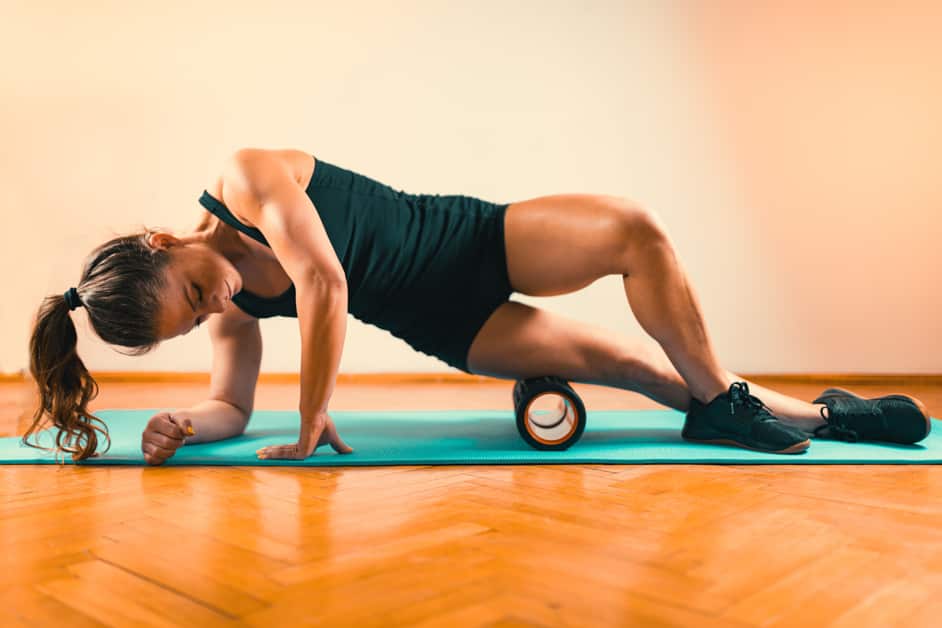Introduction
Foam rolling is a widely-used massage technique and self-myofacial release method. Runners employ it to reduce knee pain. It works by pressing a foam roller on the soft tissues of the body, helping to break apart adhesions, loosen knots, and improve blood flow.
This guide will tell you how foam rolling can be beneficial for runner’s knees and how to do it correctly.
What is foam rolling?
Foam rolling is a type of self-myofascial release (SMR). It includes rolling different parts of the body on a foam roller. It’s a great way to reduce tension, knots, and muscle soreness. Plus, it can prevent or help with injuries, improve posture and flexibility, and decrease stress.
Runners with knee pain should warm up and cool down with dynamic stretches. Foam rolling before and after workouts is an effective way to reduce tension in the muscles around the knee joint. This helps prevent or reduce knee injuries such as patellar tendinitis and IT band syndrome. And, it increases blood flow to the affected area, providing more oxygenated blood for faster healing.
Benefits of foam rolling for runners with knee pain
Foam rolling is an easy & cheap exercise technique to address running & knee issues, like pain. It’s said that foam rolling helps improve mobility, flexibility, & muscle tension. It can also break up adhesions, improve circulation, & speed up recovery after exercise.
Though there aren’t many studies on foam rolling for runners with knee pain, many report great benefits. Specialty-centric exercises can give pain relief & strengthen the muscles around the knee, which are needed for balance & stability when running. Stretching tight tissue before running can help prevent injury while getting the flexible & motion benefits of running. Regular foam rolling also reduces muscular soreness from long runs or sudden mileage increases, which helps performance.
Foam Rolling Techniques
Foam Rolling is a self-myofascial release method. It’s often used by runners who have knee pain. It can be beneficial in reducing pain, increasing mobility and even boosting performance.
In this guide, we’ll see different Foam Rolling techniques for runners with knee issues. These techniques can help reduce pain and improve mobility.
IT Band Release
The Iliotibial (IT) Band is a thick bundle of tissue that helps stabilize the hip and knee. It connects these joints, with most of its attachment on the outside of the knee. When it gets tight, it puts pressure on parts like the kneecap and lateral collateral ligaments.
Foam rolling can reduce stiffness in this area and help with mobility.
Start by lying on your side, with the affected leg close to you. Put the foam roller above where you feel discomfort. Make sure the pressure is effective, but not too much to hurt. Roll slowly down to just above the knee joint and back up to the hip around 5 times. When you reach tender areas, do small rolling moves until they relax. Change the pressure if it’s too uncomfortable. For an even deeper massage, use a spiked massager ball instead of a regular roller. Doing this during your running program can help reduce knee pain associated with running activities.
Gluteal Release
The illiotibial band (IT Band) is a tough fascia that stretches from the hip to the outside of the knee. It is often responsible for knee pain in runners. Foam rolling this area can be used to loosen muscles and connective tissues, helping restore flexibility.
Gluteal Release Technique:
- Sit on your foam roller.
- Extend your legs out and cross ankles.
- Place hands at the sides for balance.
- Shift weight onto one buttock.
- Roll slowly up towards your lower back. Stop at any painful or tender areas. Apply pressure to massage away tightness.
- For extra intensity, cross one ankle over the other.
- Do 3 sets of 30-second holds per side. Switch exercises.
Quadriceps Release
Quadriceps release is a foam roller technique to ease tightness and discomfort in the quadriceps, or front thigh muscles. It’s especially helpful for runners who experience knee pain from tight or overused quads. Using a foam roller correctly can help reduce tension, boost flexibility and mobility, restore balance, and even reduce pain or soreness in feet, calves, and legs.
To foam roll quads effectively:
- Lie on the foam roller, with your weight at your thighs.
- Put your forearms flat on the ground, parallel to each other.
- Roll slowly down the length of your quads.
- When you find a tender spot on one side (or both) of your thigh, pause and hold for 10-30 seconds.
- Move back up until you reach the top of your thigh, and repeat on both sides.
- Stand up when you’ve achieved the desired level of relief.
Hamstring Release
Runners with knee pain often overlook the hamstrings. But they are critical for injury prevention. To release tight muscles in your hamstrings, start by sitting on the floor. Place a foam roller under the back of your thigh. Move forward and apply firm pressure. Roll up and down the roller from below your hip to the back of your knee. Spend extra time on tender spots. Move slowly, not quickly.
Next, lie on your side. Put the foam roller under your hamstring. Bend your knee at a 90 degree angle. Use the bent knee as a fulcrum when you roll up and down the muscle fibers. Don’t be shy about applying direct pressure onto tender areas for 10-30 seconds until you get some relief. With experience, you’ll be able to identify the areas that need attention.
Lastly, use dynamic stretching like straight leg raises to target any remaining tightness after foam rolling your hamstrings.
Calf Release
Foam rolling your calf and Achilles tendon can help break up adhesions. It’s great for anyone with knee pain caused by tightness in the calves.
Position the foam roller above the ankle. Roll up and down slowly to massage the area, paying attention to tight or tender spots. Spend 30-60 seconds on each area. Cover the entire length of the lower leg. Once complete, move onto foam rolling the Achilles tendon.
Tips for Foam Rolling with Knee Pain
Foam rolling is a terrific technique to release muscle tension, increase flexibility, and decrease inflammation. Especially for runners, using foam rolling on knee pain can be really handy. Doing foam rolling on a regular basis can lower knee pain, boost mobility, and upgrade joint function.
Let’s go deeper into this topic and go through some advice for foam rolling with knee pain:
Start with a low intensity
When foam rolling with knee pain, it’s important to start at low intensity. Avoid the inflamed area and massage the soft tissue and muscles around it. Gradually move towards the sore area as your body adjusts.
Focus on breathing while foam rolling. Inhale deeply into your core as you roll, exhale fully as you move away. Stay mindful of your breath to avoid tensing up when hitting a tender spot. Breathing should become slow, regular and relaxed.
Find the right amount of pressure. Too light won’t help, too hard may irritate. Start on muscles farther away from the affected area. Introduce more concentrated strokes with extra caution when less soreness. Work through chronic tightness completely.
Focus on breathing
When foam rolling, focus on breathing. This will help relax muscles and make the roller more effective. Inhale deeply and slowly as you lower body onto roller. Exhale gently as you move. Close eyes and concentrate on feeling points of contact between body and roller.
Press slowly, roll one or two inches at a time with even pressure. Feel small knots and work them over 10-30 seconds using circular motions. Press in and hold for 10-30 seconds while focusing on deep breaths. Get better feedback by asking someone else to do the rolling. Some discomfort is normal.
Foam Rolling for Runners with Knee Pain: A Complete Guide has dozens of tips to improve muscle flexibility from top to toe. It includes instructions specifically designed for foaming roller exercises around knee pain associated with running injuries.
Use the right amount of pressure
When foam rolling for knee pain, ensure you apply the correct pressure. Not too hard, just enough for a deep massage. Move slowly and take your time when rolling out the knees. If it’s too painful, talk to a doctor or PT. Listen to your body – if it feels off, stop. Don’t expect results overnight. Consistent use is key.
- Rest between each session
- Stay hydrated!
Roll slowly and deliberately
When foam rolling with knee pain, it’s important to roll slowly and deliberately. Start by backing off on the foam roller to find the most tender spot. Pause here and let gravity sink in for 20-30 seconds. It may be uncomfortable, but it shouldn’t hurt. Increase the pressure and roll slowly across the length of your thigh or calf. This should create warmth in the tissue, releasing tension from your knee joint area. Don’t roll directly on your knee – work around and above it instead.
With consistent foam rolling and specific stretching exercises, you may reduce pain in your knee joint. If any activity makes your knee pain worse, or it persists for more than 3-4 days, see a health professional for proper diagnosis and treatment tailored to you.
Conclusion
To sum up, foam rolling is a great option for runners suffering from knee pain. Doing it regularly, after each run, can help keep knee joints flexible. Plus, foam rolling reduces inflammation and tension in the muscles around the knee. Thus, it’s an awesome tool for runners to keep their muscles relaxed and free from pain.
Summary of foam rolling techniques
Foam rolling for runners with knee pain has a few methods. These include working on the IT Band and quads, using a ‘stripping’ technique on the muscle, and cross-friction massage to reduce restrictions in the soft tissue. Also, pre-run and post-run stretching is good.
Joint mobility exercises and dynamic stretches in the pre-run warmup are beneficial. This can help the knee and other body parts. Afterwards, static stretching at an easy speed can increase flexibility and shorten recovery.
So, foam rolling can help lessen knee pain while running. It focuses on weak core stability or paired imbalance. However, it needs to be combined with the right warmup and stretching to get the most benefit.
Additional tips for foam rolling with knee pain
Foam rolling is great for easing knee pain and tightness. But, you must be careful. If not done right, it can lead to injury. To benefit from foam rolling, here are some tips:
- Don’t roll directly on the knee joint. Instead, massage the muscles around it, e.g. quads, hamstrings and glutes.
- Take your time. Each repetition should last 10 seconds.
- Breathe deeply when rolling. This will help you relax and reduce tension.
- Target specific areas. If your discomfort is in a certain spot, use exercises to work it out.
- For best results, foam roll before running. This will loosen up tight muscles and make running less tough.
Frequently Asked Questions
Q: What is foam rolling?
A: Foam rolling is a form of self-myofascial release (SMR). It is a form of massage therapy used to help treat muscle pain and tightness. It is done by rolling a foam roller over the affected area, applying pressure to the tissue and helping to improve flexibility, mobility, and circulation.
Q: How does foam rolling help runners with knee pain?
A: Foam rolling can help runners with knee pain by increasing flexibility and range of motion in the affected area. It can also help reduce muscle tension and improve circulation to the area, which can help reduce pain and improve recovery time between runs.
Q: How often should I foam roll to see results?
A: Foam rolling should be done at least three times a week to see results. It is best to foam roll before and after running to help reduce pain and improve recovery time. It is also important to foam roll all areas of the body, not just the area in which you are experiencing pain.





